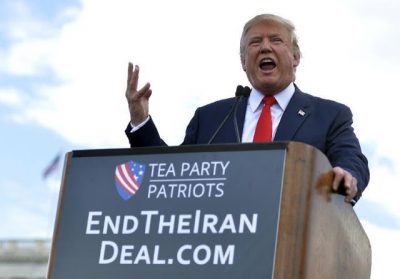Trump’s Failed Coup in Iran

Listen to the state-‘guided’ US media this past week and you’d believe a series of spontaneous anti-government protests broke out across Iran. The protests, according to President Donald Trump and his Israeli allies, were caused by `anger over Iran’s spending billions on wars in Syria, Iraq and Lebanon and helping the Palestinian movement Hamas.’ Trump tweeted that Iranians were finally rising up against what he called their hated, brutal regime.
Talk about manufactured news. Most Iranians were elated and proud of their nation’s role in thwarting US plans to occupy much of Syria and overthrow the government of President Bashar al-Assad. By contrast, the other side in this long proxy war – the US, Israel, Saudi Arabia and Britain – was smarting with defeat and seeking ways to exact revenge on the hateful trio, Syria, Iran and Russia.
Interestingly, the so-called news of protests over Iran’s military spending did not apparently originate in Iran but rather in Washington which spread it far and wide to our state-guided media. This was clumsy, but the US and Israel were so eager to get this piece of made-up good news out that they forget the basics of propaganda management: wait for the event before you proclaim it.
What in fact was going on in Iran where more than 21 demonstrators have died violent deaths? As a very long-time Iran watcher allow me to explain.
Restive minority groups in Iran’s Kurdish, Azeri and Sunni Arab regions, most far from the big cities, have been demonstrating and protesting severe economic problems. Iran is a big, resource-rich nation of 80 million people that should be booming. But it has been under economic siege warfare by the US and its allies ever since a popular uprising in 1979 overthrew the US-British backed monarchy that was raping the nation and keeping it a vassal of the western powers.
Iran’s new Islamic Republic was deemed a dire threat to Western and Israeli strategic and military interests (think Saudi Arabia). The very idea that the Islamic Republic would follow the tenets of Islam and share oil wealth with the needy was anathema to London and Washington. Israel’s intelligence agency, Mossad, ran Iran’s dreaded, brutal secret police, Savak. The crooked royal family looted the nation and stored their swag in California.
The West’s first act was to induce Saddam Hussein’s Iraq to invade Iran, in Sept 1980. The West (including the Gulf Arabs) armed, financed and supplied Iraq. As I discovered in Baghdad, Britain and the US supplied Iraq with poison gas and germ warfare toxins. After eight years, 250,000 Iraqis were killed and nearly one million Iranians died.
Ever since the Islamic Revolution, the US, Britain, Saudi Arabia and the Gulf Arabs have been trying to overthrow the Tehran government and mount a counter-revolution. CIA and Britain’s MI6 has ample practice: in 1953, the CIA and MI6 mounted an elaborate operation to overthrow Iran’s democratically-elected leader, Mohammed Mossadegh who sought to nationalize Iran’s British-owned oil company. Mobs of specially trained anti-Mossadegh plotters poured into Tehran’s streets. Bombs went off. Army commanders were suborned, lavish bribes handed out.
The 1953 coup went perfectly. Mossadegh was ousted with backing from the Army and Savak. Iran’s oil remained safe in western hands. The successful Iran uprising became the template for future ‘color revolutions’ in Georgia, Ukraine, Azerbaijan, Russia, Poland, and Romania.
But in 2009 a US-engineered ‘color revolution’ in Iran went badly wrong even though it used all the latest arts of social media to whip up protestors and deploy them in the streets. Something similar happened in Iran this past weekend where mobs of 20-somethings, agitated by US and British covert social media, poured into the streets of dingy provincial towns.
As of now, this medium-sized uprising in Iran looks to be over, though it could re-ignite at any time. Young Iranians, at least 40% of the population, suffer due to 50% unemployment. Iran’s $1 trillion economy is extremely fragile and in some cases barely functioning after decades of US-engineered economic warfare and boycotts. High unemployment is a result of US economic warfare and bullying other nations not to do business with Iran, producing 13% overall unemployment and a 40% inflation rate. The latter and wide-scale corruption were the spark that ignited the latest riots.
In two more weeks, President Trump, who makes no secret of his hatred and contempt for Muslims, must decide whether to reaffirm the multilateral nuclear energy deal with Iran or heed Israel’s demands and refuse to certify it. His cutoff this week of US military aid to Muslim Pakistan bodes ill for Iran.
Many Iranians observing the current US-North Korea nuclear standoff will wonder if their nation was not better off continuing its nuclear program and holding the Saudi oil fields at risk to deter a US attack. Trump’s wild, inconsistent and often infantile responses on this issue are making matters murkier…and ever more dangerous.
*
Featured image is from New Eastern Outlook.

